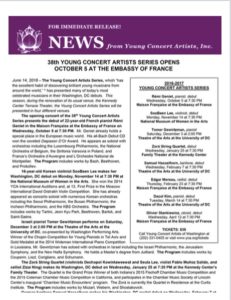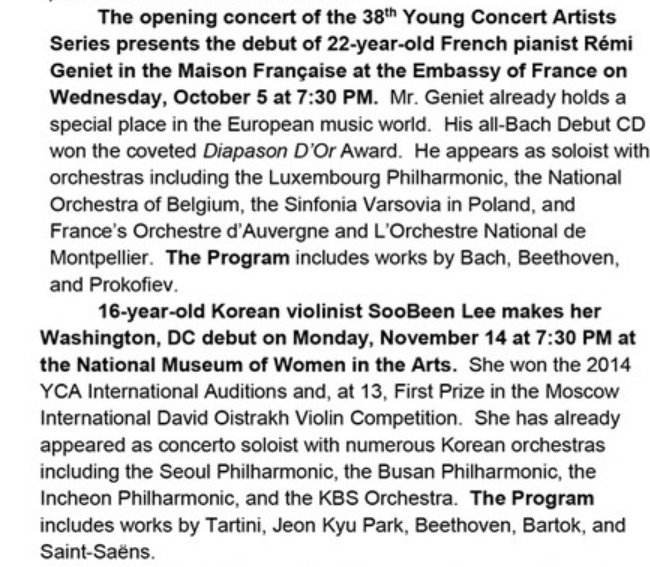My Juilliard course this fall is well underway, and its title (slightly shortened for clarity) is “How to Speak and Write About Music.”
We read descriptions of music, by critics and others. We practice describing music I play in class.
And, in the spirit of entrepreneurship, we study press releases, bios, and program notes to see how they’re written. And — you knew this was coming, if you’ve read me on these subjects — how they could be written better.
They do a terrible job, so many of them, describing the music they’re trying to sell.
Here’s an overview of the course, and a week by week class schedule, with links to all assignments.
A sad example
One press release we read comes from Young Concert Artists, a preview of their current season.
And…what to say? I’ll try to be gentle. But I have to admit I’m distressed, for the organization and above all for the young musicians who win their competition, and whom they promote.
Just to start, these musicians deserve a press release that looks better than the one YCA sent out. Here’s the first page:
So unappealing. I look at it, and I don’t want to read what it says. All those words, clumped so clumsily together. No white space, no room to breathe. And that heavy purple banner at the top, so discouraging to look at.
Then, when I do read the text…
…it tells me nothing I want to know
First the implausible claim that the pianist “holds a special place in the European music world.” He may have won a fine award, but he’s just begun his career. And since the orchestras he plays with aren’t exactly Europe’s most famous, the claim seems even less sustainable.
Next comes a violinist who — this sounds familiar — won a competition and played with orchestras whose names don’t resound around the world. (Which of course doesn’t reflect badly on her, or on the pianist. You don’t play with the world’s top orchestras at the start of your career. It’s just that, for most of us, the names of the orchestras won’t mean very much.)
And so on we go, through seven soloists and one string quartet. Each has won [ ] and [ ] (fill in the blanks with names of competitions or awards), and has played with [ ], [ ], ], and [ ] (fill in the names of orchestras).
The pattern itself, repeated so many times, feels oppressive. And there’s nothing in the release that’s interesting. Nothing to make you want to hear these people (who may, for all I know, be truly wonderful).
They’re all described the same way, with the same information. I feel like I’m being hit with a club. Competitions! Orchestras! Awards!
Of course these musicians have had some success. I could have guessed that before I read the press release.
So, please, let’s move on from there. Tell me something compelling about each musician. What kind of music do they make? What are their thoughts about the music they play? What kind of people are they?
If you don’t do that, the press release fails. It does the opposite of what it ought to do. Instead of making me want to hear these musicians, it turns me away. Again, these might, for all I know, be the most stimulating young musicians I’ll ever hear. But the press release does nothing to make me think that.
And now, to be fair…of course I know that classical music press releases are commonly written this way. So it’s just a little arbitrary to single this one out. I apologize to YCA for taking them as an example.
But still! They can do better. All of us can. And in their case, I’m sad that in this release (and others from them I’ve seen) they don’t do much to make us interested in their competition winner. So (with apologies for speaking plainly) they’re a disservice to the young artists YCA works so actively to help.
What I can do
If YCA would care to contact me, I’d be happy to help them. In an hour, I could teach them to write a better press release. (And I could teach others as well)
My suggestion might be this. Start by saying that these musicians, all of them, have distinguished themselves at an early point in their careers. They’ve won awards, and appeared as soloists with orchestras.
And so their future could be bright. I’d then add that details of what they’ve done — the names of the awards and orchestras — could be found later in the press release. I think they should be in there, because at least a few classical music professionals might read this release, and to some of them, the names of the awards and orchestras might mean something. (As they won’t to almost everyone in the media, the people the release is aimed at.)
But what’s most compelling [I’d then say] is how different these musicians are, how varied their music-making is. For each musician I’d supply a quote, in which each says something that might make us want to hear them play.
I love Beethoven. I’m young, and still learning about life. But Beethoven takes me to places I didn’t know were there.
I’m Danish, so I pretty much have to play Nielsen. To be honest, at first I didn’t like his music. But then something changed in me, and now I know it speaks my language.
I’m playing a contemporary harp piece on my recital, and once when I was practicing it, my brother came into the room. He doesn’t listen to classical pieces. ‘Wow,’ he said, ‘I thought classical music had to be pretty. But this is different! This piece really makes me think.
I made the first two up; the third is paraphrased from something a student told me when I taught at Eastman.
Where would you find quotes like these? Talk to each musician, for half an hour or so. And if they’re really engaged in the discussion, and engaged with what they love about music, I can almost guarantee that they’ll say something that will light up the press release.
I’ve written a blog post with many examples of compelling things to put in press releases. Not that I’m saying what I’ve written is brilliant! Or that it solves the press release problem forever. I’ve just tried to show the way. Once you start doing this yourself, you’ll find great things on your own.



Great post. I used teach “Public Relations for Nonprofit Organizations” at the NYU School of Continuing Education. I always brought in a handful of poorly written press releases so we could critique them. In this day of electronic communications, clear, concise writing is more important than ever.
The other “problem area” is the artist bios which their managers send us to put in our program books. They are almost always awful, useless. “In 2015, Mr. X performed with the orchestra of —–. In 2014, Mr. X performed with the orchestras of —. In 2013 Mr. X performed with the orchestras of —.” They usually go back to the time Mr. X was 6 years old playing an elf in the church Christmas pageant!
Bios are awful, I agree. We talk about that in my Juilliard course on How to Speak and Write About Music.
It’s sobering that my students see the problems, understand that the standard bios are unreadable, but are reluctant to change. AS they see it, they’re just starting out, and the gatekeepers they’ll need to please don’t want different bios. Plus, in purely professional circles, the kind of bio that’s essentially a list can tell someone quite a bit. “She studied with HIM? And now only has this and that concert? No surprise.” Very good, sigh, for gossip and backbiting.